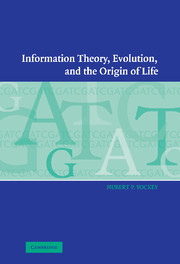Book contents
- Frontmatter
- Contents
- Preface
- 1 The genetic information system
- 2 James Watson, Francis Crick, George Gamow, and the genetic code
- 3 The Central Dogma of molecular biology
- 4 The measure of the information content in the genetic message
- 5 Communication of information from the genome to the proteome
- 6 The information content or complexity of protein families
- 7 Evolution of the genetic code and its modern characteristics
- 8 Haeckel's Urschleim and the role of the Central Dogma in the origin of life
- 9 Philosophical approaches to the origin of life
- 10 The error catastrophe and the hypercycles of Eigen and Schuster
- 11 Randomness, complexity, the unknowable, and the impossible
- 12 Does evolution need an intelligent designer?
- 13 Epilogue
- Mathematical appendix
- Glossary
- References
- Index
11 - Randomness, complexity, the unknowable, and the impossible
Published online by Cambridge University Press: 15 August 2009
- Frontmatter
- Contents
- Preface
- 1 The genetic information system
- 2 James Watson, Francis Crick, George Gamow, and the genetic code
- 3 The Central Dogma of molecular biology
- 4 The measure of the information content in the genetic message
- 5 Communication of information from the genome to the proteome
- 6 The information content or complexity of protein families
- 7 Evolution of the genetic code and its modern characteristics
- 8 Haeckel's Urschleim and the role of the Central Dogma in the origin of life
- 9 Philosophical approaches to the origin of life
- 10 The error catastrophe and the hypercycles of Eigen and Schuster
- 11 Randomness, complexity, the unknowable, and the impossible
- 12 Does evolution need an intelligent designer?
- 13 Epilogue
- Mathematical appendix
- Glossary
- References
- Index
Summary
“It's no use trying,” said Alice. “One can't believe impossible things.” “I dare say you haven't had enough experience,” said the White Queen. “When I was your age, I did it for an hour a day. Why sometimes, I've believed as many as six impossible things before breakfast.”
Alice in Wonderland, Lewis Carroll (1832–1898), aka Reverend Charles Lutwidge DodgsonOrderliness, randomness, and self-organization
There has long been considerable opinion in the literature that life must be nonrandom and appears because of self-organization (Eigen, 1971). Many authors appeal to pattern formations that abound in Nature, such as crystal structure, stripes on a zebra, snowflakes, oil drops in water, hurricanes, and ripples on a river bed. It is often said that the crucial event in the origin of life is the saltation from a disordered state to an ordered state (Chaisson, 2001; Dyson, 1982; Schrödinger, 1987, 1992).
What has really happened, if we compare the two selected species after the restoration of the steady states, is a change in “valued information” which is reflected in an increased order.
(Eigen, 1971)Thus, combinatorial explosion is a universal threat to biopolymer sequences and structures as well as reaction and controlling networks. Examples are known from biology, in particular metabolic, genetic, developmental, signaling, and neural networks. If this is true, how then, can organized objects originate? Must not all processes that are not regulated externally end up in a highly diverse mess of molecular species, each one at best realized in a few molecules? […]
- Type
- Chapter
- Information
- Information Theory, Evolution, and the Origin of Life , pp. 164 - 175Publisher: Cambridge University PressPrint publication year: 2005



